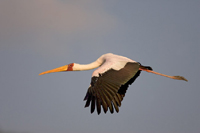Waterbirds population declines because of global warming
Nearly half of the world's waterbird species are in decline, mostly due to rapid economic development and the effects of climate change, according to a global survey released Tuesday.

The fourth annual Waterbird Population Estimate found that 44 percent of the 900 species globally have fallen in the past five years, while 34 percent were stable, and 17 percent rising.
Altogether, 12 families of birds have half or more of their global populations showing a decreasing trend, including storks, shoebills and plovers.
The worst decreases occurred in Asia, where 62 percent of the waterbird populations had declined or become extinct. That was followed by a 48 percent decline in Africa, 45 percent in Oceania, 42 percent in South America, 41 percent in Europe and 37 percent in North America.
Simon Delany, a waterbird conservation officer for Netherlands-based Wetlands International which coordinated the survey, said the cause of the decline was a loss of wetlands either from economic and agriculture development rising temperatures which are blamed for worsening droughts and rising sea levels.
The survey represents about 50,000 hours of field work done in 100 countries.
"The most frequent known cause of population decrease is habitat destruction, often caused by unsustainable human activity," Delany told The Associated Press.
"The frantic pace of economic development is clearly having adverse impacts on the environment, including numbers and population trends of waterbirds," he said. "Human impacts such as urban sprawl, reclamation of wetlands, increase of pollution and hunting pressure can develop rapidly and conservation considerations are often not taken into account."
Darters, Screamers, Rails, Finfoots, Jacanas, Painted-Snipes, Stone Curlews, Seedsnipes and Skimmers were other species that have gone into decline, the report said.
Delany said the threats are especially visible in Asia, where mangroves are being destroyed to make way for shrimp and fish farms and wetland are increasingly being reclaimed for industrial estates and tourist resorts.
South Korea, for example, has converted about half the country's 400,000 hectares (988,400 acres) of tidal flats for commercial purposes while China has taken half its mangrove forests since 1949 for land reclamation and aquaculture.
"Land reclamation is simply removing huge areas of wetlands which means very large number of birds and other species have no where to live," Delany said. "Many of these birds are long distant migrants so they need these places to feed. If there is nothing available for them, they can't survive."
But Delany and others said there were positive developments in the survey, especially in Europe and North America where most bird populations are either stable or on the rise.
He attributed that to stabilizing human populations as well as greater environmental awareness which has led to stronger regulations and greater protection of wetlands, the AP reports.
A good example, he said, was the creation of the European Commission's Bird Directive which requires members to set aside areas for bird conservation. "These kinds of policies are in their infancy in Asia and Africa," Delany said.
Mike Crosby, research & data Manager for Birdlife International, said the findings were what most bird experts would have expected and served as a reminder of the urgency to set aside the most threatened wetlands for protection.
"The protection of really important wetlands needs to be strengthen and in some cases cite specific projects are needed to find a balance between the needs of local people and biodiversity conservation," Crosby said.
Subscribe to Pravda.Ru Telegram channel, Facebook, RSS!





